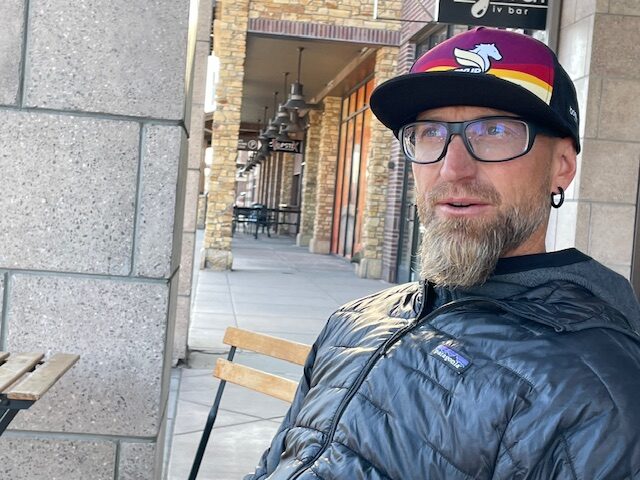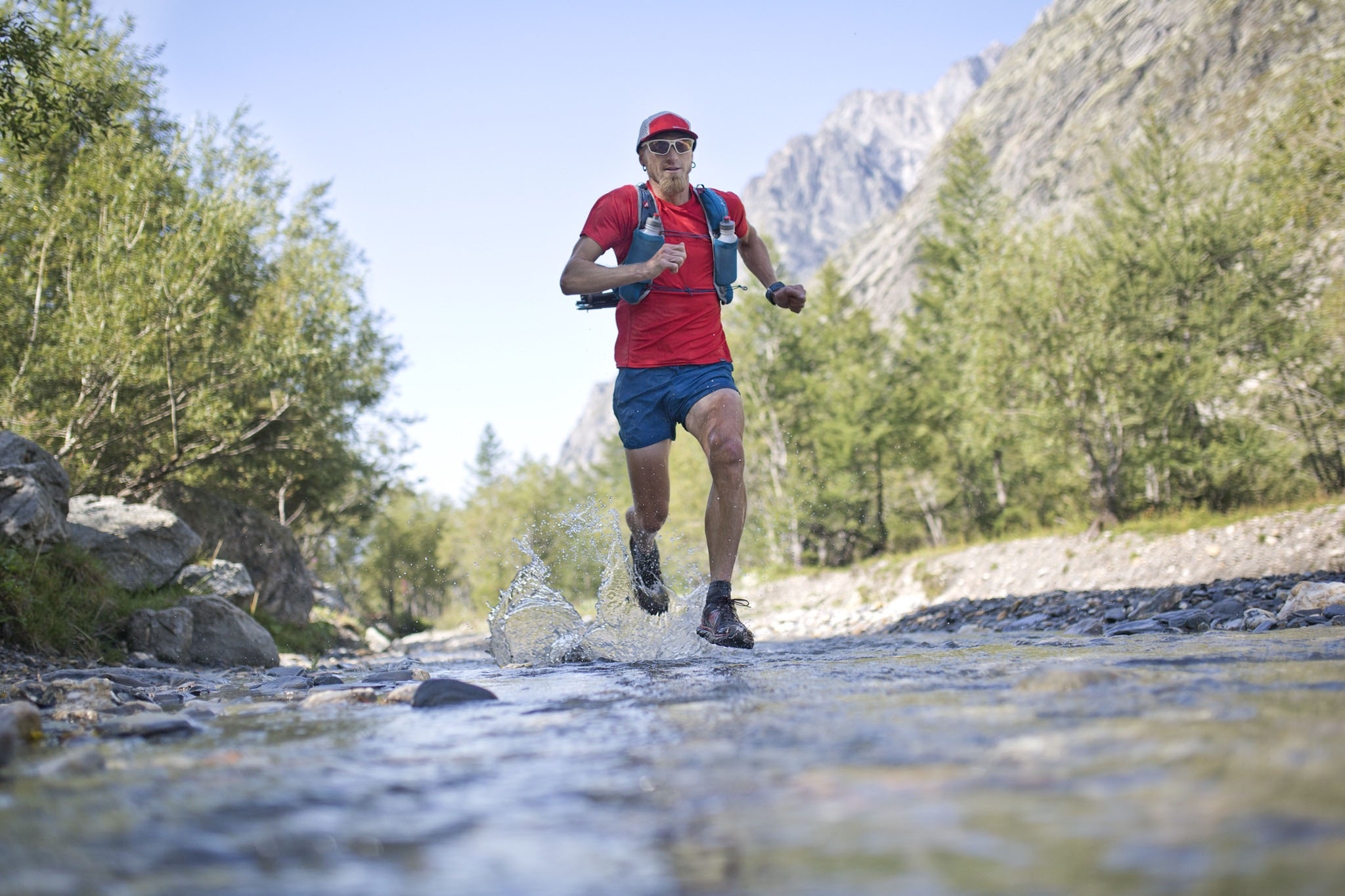This is another in a series of profiles of Flagstaff runners who will be tackling the Cocodona 250 next month from Black Canyon City to Flagstaff. (Photo Credit, top: Lloyd Belcher)
Gray has not quite yet overtaken brown as the dominant color in Jeff Browning’s signature goatee. Flecks have turned to threads in recent years and, one day, may stage a facial-hair hostile takeover.
They say a touch of gray is distinguished in a man of a certain age. But for Browning, it only makes him seem more intimidating, even more of a badass, out on the trails.
At 52, Browning, a Flagstaffian since 2021, has shown little, if any, signs of slowing down, few effects of the ravages of time that claim us all. If anything, with age has come guile and wisdom refined and burnished an already lauded ultrarunning career.
Since taking up the sport relatively late at age 28, Browning has won no less than 30 100-mile races, second only to Karl Meltzer’s seemingly untouchable 41 victories. He has forged an indelible identity in the quirky world of ultras as the wild and fearless “Bronco Billy,” up for any challenge. And now, on May 6, he’ll find himself lining up once more against the young bucks for the Cocodona 250 – a grueling test of endurance, skill and (yes) speed – from Black Canyon City to Flagstaff.
Here, for the most part, is the cast of elite ultra runners Browning will face: Michael McKnight, the defending champion and course recordholder; Joe “String Bean” McConaughy, holder of the fastest known time on the Arizona Trail; Arlen Glick, a sub-16-hour Western States 100 finisher; Michael Versteeg, winner of the inaugural Cocodona in 2022; and Jeff Garmire, a Montanan who won four ultras in 2023.
What do all these contenders have in common (aside from a yen to run a long, long ways)?
They are in their 30s – ultrarunning prime.
Not to put too fine a point on it, but Browning is almost old enough to be these guys’ father. And, in fact, he is McKnight’s coach, creating the interesting situation of mentor and mentee squaring off.
If you think the age differences fazes Browning, well, then, you haven’t spent much time around him. Scouting out the field – this will be Browning’s second 200-plus miler, having set the course record at the Moab 240 in October, 2022 – Browning is almost boyish excitement.
“This is probably the deepest 200 (mile) field in the U.S. there ever has been,” he said. “I mean, even when we look at the last few years at Cocodona, there were a couple guys who were solid. But this year there are tons of threats. It’s going to take a faster time, a course record, to win. At least, that’s my prediction – low 60s (hours). I think the winner will (finish) in the daylight on Wednesday, before sunset. It’s going to take that kind of time to win.”
Behind his black horned-rim glasses and omnipresent trucker’s hat, Browning exudes the confidence, sometimes bordering on cockiness, of youth. Yeah, sure, he thinks he can win, age by damned. He may stroke his beard occasionally like some philosophical old sage, but Browning refuses to let chronological age slow him.

Truth is, though, most elite ultrarunners have been put out to pasture by the mid- to late 40s – age 50, tops. By that time, they are either burned out, chronically injured, bereft of motivation, or overwhelmed by life’s responsibilities. Or all of that.
Not so with Jeff.
He’ll be 53 in August, and he is redefining the limits of competitive ultrarunning.
“I hope so,” he said about pushing limits, “this’ll be my 24th season.”
Ask him how he does it, and Browning takes a sip of his early-morning latte at Lund Coffee, and hems and haws a little before launching into a detailed explanation that he probably has told people scores of times, most certainly the stable of ultrarunners of all abilities that he coaches.
It boils down to the following, he says: consistent training, motivation, nutrition, strength training, and mobility. Not necessarily in order of importance, but all integrated seamlessly into his lifestyle. He’s married and two of his three children are grown; his 12-year-old son is home-schooled.
“There’s a lot of other factors that go into longevity that are not running,” Browning said. “Running, the training part, is just a piece. You have to be motivated. That’s one. In the running vertical, you have to have the motivation to train, get out the door every day and do the work. That’s hard to do for 25 years straight. Life happens.
“Then, with elites, ego gets in the way. You start to slow down and realize you can’t perform at the same level. But the training for me hasn’t changed a ton over the last seven to 10 years and I don’t feel I’m slowing down much.”
Which leads Browning into an extended explanation of what he calls “the three key pieces”: nutrition, mobility and strength.
“Wait, intuition goes in there, too, like knowing when to back off, knowing your body because of experience,” he said.
Browning doesn’t often do triple-digit training weeks – more like, between 50 and 75 – though he has logged several ultra-long training runs in this build up, covering perhaps 95% of the Cocodona course.
“It’s not necessarily big volume, just consistency over months and years,” he said. “I’ve gone to three days on (running), one off, then three days on – with one cycling session on my day off. I do a decent amount of vert (vertical gain, aka, hills)and speedwork. I’ve approached volume methodically. My first decade in the sport, because I was newer in it, I found I could add 10% volume every year. My sweet spot for a decade, in a peak block, was 75 to 95. It’s always trail.
“This year, I’ve been playing around with a little higher volume and playing around with doubles. I have more time now. In my coaching business, I have assistants now. That helps. My lifestyle is set up so I can do all the work, the little stuff, go to the gym three days a week. Strength training, body work, foam rolling, massage a couple times a month.”
What he does daily, though, is closely monitor his nutrition. In his earlier days, Browning was more of a high-fat, low-carb runner. Now, he’s tweaked it into a more high-protein model.
“Nutrition is most important to me – animal-based,” he said. “It’s not really high fat, low carb anymore. It’s evolved into high protein, moderate fat and still low carb, but that means under 200 grams per day. If you redid the (food) pyramid, the bottom two thirds would be animal products and raw dairy. Then it would be fruit and starch, like potatoes. And then the top little triangle would be veggies, dark chocolate, some wine, clear liquor. I try to avoid beer, grains, sugar and seed oils in my everyday diet.”
There’s an important caveat, though.
“Obviously,” he added, “simple carbs are on for race day and long runs. I use Tailwind and Gu. But I do eat a lot of protein, 150 to 180 grams a day. They say eat 1.1 to 1.3 grams per pound of body weight, and I’m at 142 pounds. This morning, I’ve already had over 30 grams of protein for breakfast.
“This diet, it lets you recover (from hard runs) so fast. The inflammation is low.”
He’s no dietary zealot, though.
“Yeah, I’m not 100% compliant,” he said, smiling. “A couple of meals a week, I don’t worry. My wife makes a long-fermented sourdough, and that’s the one bread I’ll have. Well, I’ll occasionally have a bun on a burger or French fries, but I’m never having them (on) back-to-back meals, right? One meal done, then back on the straight and narrow.”
The diet, combined with strength training helps him maintain muscle mass, which declines at least 1% per year naturally with aging. He does a dumbbell lifting routine three times a week and a 10-minute mobility exercise routine. It’s needed, he said, to stave off decline.
“We lose our range of motion (as we age), so we don’t move well anymore,” he said. “And that’s when we get hurt, as we age. We trip but we can’t do a deep lunge anymore , so you can’t catch yourself, can’t put a hand down and lunge out, so you fall and break a hip. Mobility and strength, for me, is vital. The protein keeps the muscle, and the strength (training) just helps maintain muscle mass. That’s all I’m trying to do – maintain — in my 50s.”
He’s also still trying to win races. Age group placing? Puh-leeze. Browning won’t settle for anything other than overall victories.
And he has maintained. He won five races last year, including the “shorter” Sedona Canyons 125 he did strictly to scope out Cocodona for this year. The only year Browning has failed to win a 100-plus race is 2011 – and that still bothers him, his face scrunching up when talking about it.
“Mobility and strength, for me, is vital. The protein keeps the muscle, and the strength (training) just helps maintain muscle mass. That’s all I’m trying to do – maintain – in my 50s.”
Jeff Browning
He pulls no punches: he wants to win Cocodona. The only other 200-plus race he’s run was the Moab 240 in 2022, which he dominated. Browning dismisses the notion that he started running 200-milers because he’s losing speed as he ages.
It’s just that 200 milers have become exceedingly more popular in recent years, so it’s a natural progression for him.
“I’ve been coaching 200 mile (runners) for a while, from Mike McKnight to middle and back-of-the-packers in my business, and I’ve been at Cocodona every year (observing, pacing, etc.), so as a coach and an athlete, I wanted to understand the 200 distance more. It’s way different than a 100-miler.”
It was a victory of sorts for Browning when McKnight won Cocodona last year in a course record. The two dialed in a race plan and, despite some mistakes, that plan enabled McKnight to triumph.
“(McKnight) has made mistakes every (Cocodona), and it’s always been that section of Crown King (the initial segment), because it’s so hot,” Browning said. “We’ve done some testing in the last six months for him. We know what his sodium concentration per litre of sweat is. We know what his sweat rate is in different temperatures. We’ve done scale tests. Don’t expect him to make as many mistakes this year, as he has in the past.”
That’s good news for Browning the coach. For Browning the runner, competing against McKnight, not so good news.
But Browning has learned from McKnight as well. In winning the 2022 Moab 240, Browning only logged 1 hour 10 minutes of sleep in the 57 hours 27 minutes and 57 seconds he was on the course. Browning said his sleep mistake in Moab was that he waited too long to sleep.
“This time (at Cocodona), I’m going to sleep on night one,” he said. “In Moab, I did it like a 100 and went on through that first night. What Mcnight did (at Cocodona) last year was sleep 3 to 4 (hours) one Night One, then he didn’t have to sleep on Night 2 and was avble to push through to the finish.”
Browning’s sleep plan this time around?
“I want to try to do an hour or less total, but in better sleep, because I took a lot of dirt naps (in Moab) that were worthless,” he said. “Five-minute dirt naps, I’m trying to avoid those. You want (sleep) to be horizontal, with your crew there and have it be efficient. You need to make the most of that sleep time window. That’s my goal. It’s going to be a fast enough overall pace that sleep will be a factor in the last 100 miles.”
Can he emerge victorious at age 52 with one hour of sleep during what figures to be a 60-plus hour run?
“I don’t know,” he said, smiling. “We’ll see.”


Leave a Reply